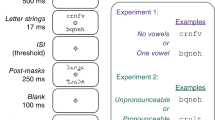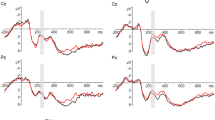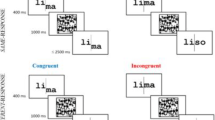Abstract
Human perception of a visual scene is hierarchically organized. Such rapid, albeit coarse, global processing allows people to create a useful context in which local details can be successively allocated. Lack of the typical hierarchical global-to-local visual processing is longitudinally predictive of future reading difficulties in pre-readers, which suggests that an atypical local perception can interfere with reading skill acquisition. Global and local Navon tasks were used to induce a transient perceptual priming before a reading-aloud task. We tested the effect of an atypical local perception on lexical and sublexical reading routes in typical adult readers. Local (vs. global) priming resulted in a slower phonological access to irregular, relative to regular, words. By contrast, pseudoword reading was not affected by local (vs. global) perceptual priming. Our findings demonstrate that, in typical adult readers, local priming impairs the fast processing of the letter string useful for lexical reading.



Similar content being viewed by others
References
Ahissar, M., & Hochstein, S. (2004). The reverse hierarchy theory of visual perceptual learning. Trends in Cognitive Sciences, 8(10), 457–464.
Ans, B., Carbonnel, S., & Valdois, S. (1998). A connectionist multiple-trace memory model for polysyllabic word reading. Psychological Review, 105(4), 678.
Bertinetto, P. M., Burani, C., Laudanna, A., Marconi, L., Ratti, D., Rolando, C., & Thornton, A. M. (2005). Corpus e Lessico di Frequenza dell'Italiano Scritto (CoLFIS). https://linguistica.sns.it/CoLFIS/Home.htm
Boden, C., & Giaschi, D. (2007). M-stream deficits and reading-related visual processes in developmental dyslexia. Psychological Bulletin, 133(2), 346.
Bosse, M. L., Tainturier, M. J., & Valdois, S. (2007). Developmental dyslexia: The visual attention span deficit hypothesis. Cognition, 104(2), 198–230.
Breznitz, Z., Shaul, S., Horowitz-Kraus, T., Sela, I., Nevat, M., & Karni, A. (2013). Enhanced reading by training with imposed time constraint in typical and dyslexic adults. Nature Communications, 4, 1486.
Burani, C., & Arduino, L. S. (2004). Stress regularity or consistency? Reading aloud Italian polysyllables with different stress patterns. Brain and Language, 90(1–3), 318–325.
Colombo, L. (1991). The role of lexical stress in word recognition and pronunciation. Psychological Research Psychologische Forschung, 53(1), 71–79.
Colombo, L., Deguchi, C., & Boureux, M. (2014). Stress priming and statistical learning in Italian nonword reading: Evidence from children. Reading and Writing, 27(5), 923–943.
Colombo, L., & Zevin, J. (2009). Stress priming in reading and the selective modulation of lexical and sub-lexical pathways. PLoS One, 4(9), e7219.
Coltheart, M., Curtis, B., Atkins, P., & Haller, M. (1993). Models of reading aloud: Dual-route and parallel-distributed-processing approaches. Psychological Review, 100(4), 589.
Coltheart, M., Rastle, K., Perry, C., Langdon, R., & Ziegler, J. (2001). DRC: A dual route cascaded model of visual word recognition and reading aloud. Psychological Review, 108(1), 204.
Dehaene, S., & Cohen, L. (2007). Cultural recycling of cortical maps. Neuron, 56(2), 384–398.
Dehaene, S., Cohen, L., Morais, J., & Kolinsky, R. (2015). Illiterate to literate: Behavioural and cerebral changes induced by reading acquisition. Nature Reviews Neuroscience, 16(4), 234.
Facoetti, A., Trussardi, A. N., Ruffino, M., Lorusso, M. L., Cattaneo, C., Galli, R., et al. (2010). Multisensory spatial attention deficits are predictive of phonological decoding skills in developmental dyslexia. Journal of Cognitive Neuroscience, 22(5), 1011–1025.
Franceschini, S., Bertoni, S., Gianesini, T., Gori, S., & Facoetti, A. (2017). A different vision of dyslexia: Local precedence on global perception. Scientific Reports, 7(1), 17462.
Franceschini, S., Gori, S., Ruffino, M., Pedrolli, K., & Facoetti, A. (2012). A causal link between visual spatial attention and reading acquisition. Current Biology, 22(9), 814–819.
Franceschini, S., Gori, S., Ruffino, M., Viola, S., Molteni, M., & Facoetti, A. (2013). Action video games make dyslexic children read better. Current Biology, 23(6), 462–466.
Franceschini, S., Mascheretti, S., Bertoni, S., Trezzi, V., Andreola, C., Gori, S., et al. (2018). Sluggish dorsally-driven inhibition of return during orthographic processing in adults with dyslexia. Brain and Language, 179, 1–10.
Gabay, Y., Dundas, E., Plaut, D., & Behrmann, M. (2017). Atypical perceptual processing of faces in developmental dyslexia. Brain and Language, 173, 41–51.
Gori, S., Seitz, A. R., Ronconi, L., Franceschini, S., & Facoetti, A. (2016). Multiple causal links between magnocellular–dorsal pathway deficit and developmental dyslexia. Cerebral Cortex, 26(11), 4356–4369.
Grainger, J., Dufau, S., & Ziegler, J. C. (2016). A vision of reading. Trends in Cognitive Sciences, 20(3), 171–179.
Grinter, E. J., Maybery, M. T., & Badcock, D. R. (2010). Vision in developmental disorders: Is there a dorsal stream deficit? Brain Research Bulletin, 82, 147–160.
Hills, P. J., & Lewis, M. B. (2009). A spatial frequency account of the detriment that local processing of Navon letters has on face recognition. Journal of Experimental Psychology: Human Perception and Performance, 35(5), 1427.
Kauffmann, L., Ramanoël, S., & Peyrin, C. (2014). The neural bases of spatial frequency processing during scene perception. Frontiers Integrative Neuroscience, 8, 37.
Kevan, A., & Pammer, K. (2009). Predicting early reading skills from pre-reading measures of dorsal stream functioning. Neuropsychologia, 47(14), 3174–3181.
Kimchi, R. (1992). Primacy of wholistic processing and global/local paradigm: A critical review. Psychological Bulletin, 112(1), 24.
Kinchla, R. A., Solis-Macias, V., & Hoffman, J. (1983). Attending to different levels of structure in a visual image. Perception & Psychophysics, 33(1), 1–10.
Kinoshita, S., & Lupker, S. J. (2003). Priming and attentional control of lexical and sublexical pathways in naming: A reevaluation. Journal of Experimental Psychology: Learning, Memory, and Cognition, 29(3), 405.
Kinoshita, S., & Lupker, S. J. (2007). Switch costs when reading aloud words and nonwords: Evidence for shifting route emphasis? Psychonomic Bulletin & Review, 14(3), 449–454.
Lawton, T. (2016). Improving dorsal stream function in dyslexics by training figure/ground motion discrimination improves attention, reading fluency, and working memory. Frontiers in Human Neuroscience, 10, 397.
Lewis, M. B., & Dawkins, G. (2015). Local Navon letter processing affects skilled behavior: A golf-putting experiment. Psychonomic Bulletin & Review, 22(2), 420–428.
Lewis, M. B., Mills, C., Hills, P. J., & Weston, N. (2009). Navon letters affect face learning and face retrieval. Experimental Psychology, 56(4), 258–264.
Li, S., Lee, K., Zhao, J., Yang, Z., He, S., & Weng, X. (2013). Neural competition as a developmental process: Early hemispheric specialization for word processing delays specialization for face processing. Neuropsychologia, 51(5), 950–959.
Lupker, S. J., Brown, P., & Colombo, L. (1997). Strategic control in a naming task: Changing routes or changing deadlines? Journal of Experimental Psychology: Learning, Memory, and Cognition, 23(3), 570.
Macrae, C. N., & Lewis, H. L. (2002). Do I know you? Processing orientation and face recognition. Psychological Science, 13(2), 194–196.
Monsell, S. (2003). Task switching. Trends in Cognitive Sciences, 7(3), 134–140.
Navon, D. (1977). Forest before trees: The precedence of global features in visual perception. Cognitive Psychology, 9(3), 353–383.
Pammer, K., Hansen, P., Holliday, I., & Cornelissen, P. (2006). Attentional shifting and the role of the dorsal pathway in visual word recognition. Neuropsychologia, 44(14), 2926–2936.
Perfect, T. J., Weston, N. J., Dennis, I., & Snell, A. (2008). Short article: The effects of precedence on Navon-induced processing bias in face recognition. Quarterly Journal of Experimental Psychology, 61(10), 1479–1486.
Perry, C., Ziegler, J. C., & Zorzi, M. (2007). Nested incremental modeling in the development of computational theories: The CDP+ model of reading aloud. Psychological Review, 114(2), 273.
Perry, C., Ziegler, J. C., & Zorzi, M. (2013). A computational and empirical investigation of graphemes in reading. Cognitive Science, 37(5), 800–828.
Perry, C., Ziegler, J. C., & Zorzi, M. (2014). CDP++. Italian: Modelling sublexical and supralexical inconsistency in a shallow orthography. PLoS One, 9(4), e94291.
Peters, J. L., De Losa, L., Bavin, E. L., & Crewther, S. G. (2019). Efficacy of dynamic visuo-attentional interventions for reading in dyslexic and neurotypical children: A systematic review. Neuroscience & Biobehavioral Reviews, 100, 58–76.
Rastle, K., & Coltheart, M. (1999). Serial and strategic effects in reading aloud. Journal of Experimental Psychology: Human perception and performance, 25(2), 482.
Rhodes, G., Brake, S., Taylor, K., & Tan, S. (1989). Expertise and configural coding in face recognition. British Journal of Psychology, 80(3), 313–331.
Seidenberg, M. S., Waters, G. S., Sanders, M., & Langer, P. (1984). Pre-and postlexical loci of contextual effects on word recognition. Memory & Cognition, 12(4), 315–328.
Share, D. L. (2008). On the Anglocentricities of current reading research and practice: The perils of overreliance on an "outlier" orthography. Psychological Bulletin, 134(4), 584.
Sigurdardottir, H. M., Ívarsson, E., Kristinsdóttir, K., & Kristjánsson, Á. (2015). Impaired recognition of faces and objects in dyslexia: Evidence for ventral stream dysfunction? Neuropsychology, 29(5), 739.
Sigurdardottir, H. M., Fridriksdottir, L. E., Gudjonsdottir, S., & Kristjánsson, Á. (2018). Specific problems in visual cognition of dyslexic readers: Face discrimination deficits predict dyslexia over and above discrimination of scrambled faces and novel objects. Cognition, 175, 157–168.
Simpson, G. B., & Kang, H. W. (1994). The flexible use of phonological information in word recognition in Korean. Journal of Memory and Language, 33(3), 319–331.
Smith-Spark, J. H., & Moore, V. (2009). The representation and processing of familiar faces in dyslexia: Differences in age of acquisition effects. Dyslexia, 15(2), 129–146.
Song, Y., & Hakoda, Y. (2015). Lack of global precedence and global-to-local interference without local processing deficit: A robust finding in children with attention-deficit/hyperactivity disorder under different visual angles of the Navon task. Neuropsychology, 29, 888–894.
Stein, J. F. (2018). Does dyslexia exist? Language. Cognition and Neuroscience, 33(3), 313–320.
Stein, J. (2019). The current status of the magnocellular theory of developmental dyslexia. Neuropsychologia, 130, 66–77.
Stein, J., & Walsh, V. (1997). To see but not to read; the magnocellular theory of dyslexia. Trends in Neurosciences, 20(4), 147–152.
Stella, G., & Tintoni, C. (2007). Indagine e rilevazione sulle abilità di lettura nelle scuole secondarie di secondo grado. Dislessia, 4, 271–285.
Szwed, M., Ventura, P., Querido, L., Cohen, L., & Dehaene, S. (2012). Reading acquisition enhances an early visual process of contour integration. Developmental Science, 15(1), 139–149.
Valdois, S., Roulin, J. L., & Bosse, M. L. (2019). Visual attention modulates reading acquisition. Vision Research, 165, 152–161.
Van der Hallen, R., Evers, K., Brewaeys, K., Van den Noortgate, W., & Wagemans, J. (2015). Global processing takes time: A meta-analysis on local–global visual processing in ASD. Psychological Bulletin, 141(3), 549.
Vidyasagar, T. R. (1999). A neuronal model of attentional spotlight: Parietal guiding the temporal. Brain Research Reviews, 30(1), 66–76.
Vidyasagar, T. R. (2019). Visual attention and neural oscillations in reading and dyslexia: Are they possible targets for remediation? Neuropsychologia, 130, 59–65.
Vidyasagar, T. R., & Pammer, K. (2010). Dyslexia: A deficit in visuo-spatial attention, not in phonological processing. Trends in Cognitive Sciences, 14(2), 57–63.
Wechsler, D. (1981). Manual for the Wechsler adult intelligence scale-revised. New York: Psychological Corporation.
Zevin, J. D., & Balota, D. A. (2000). Priming and attentional control of lexical and sublexical pathways during naming. Journal of Experimental Psychology: Learning, Memory, and Cognition, 26(1), 121.
Funding
This work was funded with Grants from the CARIPARO Foundation (Borse di Dottorato CARIPARO 2015, to S.B.; Progetti di Eccellenza CARIPARO, 2011–2012 to A.F.), a grant from MIUR (Dipartimenti di Eccellenza DM 11/05/2017 n. 262) to the Department of General Psychology, University of Padua - CUP: C96C18000450005 to S.B, and a Grant from MIUR (Dipartimenti di Eccellenza DM 11/05/2017 n. 262) to the Department of General Psychology, University of Padua. Progetto di ateneo anno 2013-CPDA130437 to SF.
Author information
Authors and Affiliations
Contributions
SF and AF designed the experiments, SF, SB, and AF performed the data analyses, SF, SG, SB wrote the paper. MM and GP performed the experiments.
Corresponding author
Ethics declarations
Conflict of interest
The authors declare that they have no conflict of interest.
Additional information
Publisher's Note
Springer Nature remains neutral with regard to jurisdictional claims in published maps and institutional affiliations.
Rights and permissions
About this article
Cite this article
Franceschini, S., Bertoni, S., Puccio, G. et al. Local perception impairs the lexical reading route. Psychological Research 85, 1748–1756 (2021). https://doi.org/10.1007/s00426-020-01326-z
Received:
Accepted:
Published:
Issue Date:
DOI: https://doi.org/10.1007/s00426-020-01326-z




